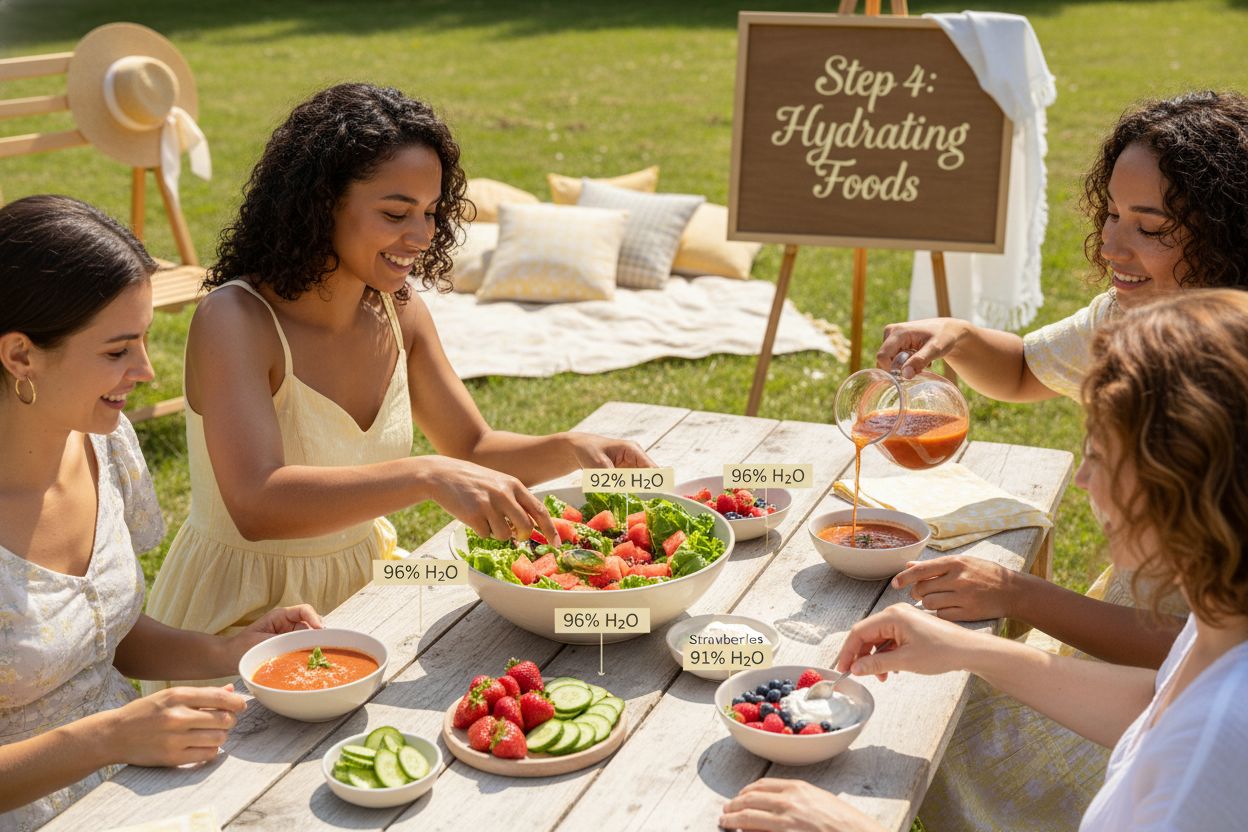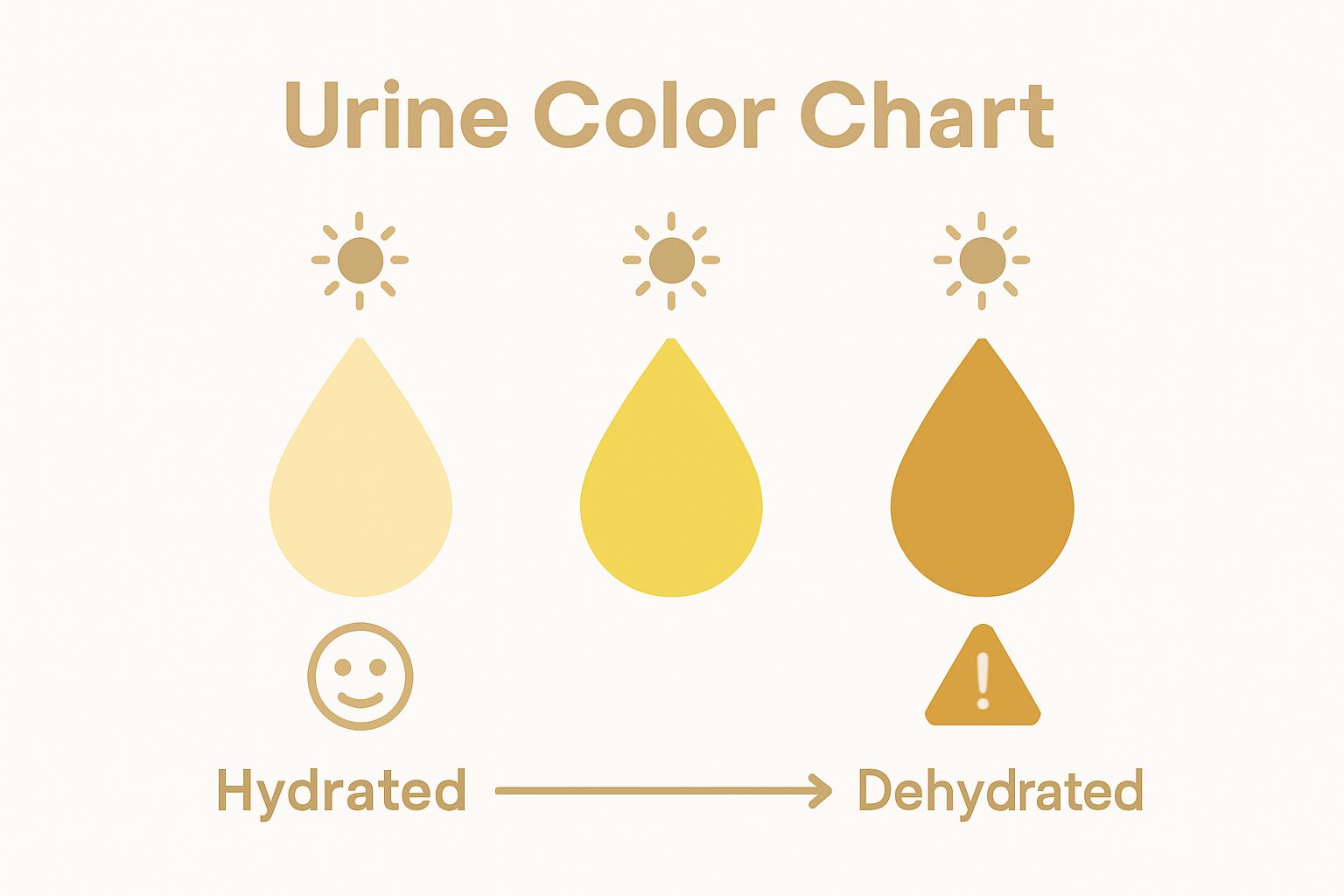Stay Hydrated in Summer: Essential Tips for Women
Summer’s heat can turn a simple day outside into a sweaty marathon, and hydration suddenly feels as important as sunscreen. Yet most women don’t realize the standard advice to drink eight glasses a day hardly scratches the surface. There’s a big surprise hiding in your kitchen: even foods like cucumbers and watermelon are up to 95 percent water and count toward your daily fluid intake. That means transforming your hydration strategy is easier and tastier than you ever imagined.
Table of Contents
- Step 1: Assess Your Daily Water Needs
- Step 2: Choose Hydration-Friendly Beverages
- Step 3: Prepare A Hydration Schedule
- Step 4: Incorporate Hydrating Foods Into Your Diet
- Step 5: Monitor Your Hydration Levels Daily
Quick Summary
| Key Point | Explanation |
|---|---|
| 1. Assess your daily water needs | Calculate water intake based on body weight and activity level; aim for about 11.5 cups (2.7 liters) daily. |
| 2. Choose hydration-friendly beverages | Opt for water, herbal teas, and coconut water; avoid dehydrating drinks like alcohol and sugary sodas. |
| 3. Create a hydration schedule | Design a daily fluid roadmap; include water intake before and after meals and during activities. |
| 4. Incorporate hydrating foods | Eat moisture-rich foods like watermelon, cucumber, and leafy greens for added hydration without excessive water. |
| 5. Monitor your hydration levels | Use urine color and physical sensations as indicators; consider apps or journals to track your fluid intake. |
Step 1: Assess Your Daily Water Needs
Summer is here, and understanding your unique hydration needs becomes crucial for maintaining optimal health and radiance. Every woman’s body is different, which means there’s no universal one-size-fits-all water intake recommendation. Your personal water requirements depend on several interconnected factors that dance together like a personalized wellness symphony.
Your baseline water needs are influenced by multiple variables: body weight, activity level, climate, and overall health status. According to Harvard Health Publishing, most adult women should aim for approximately 11.5 cups (2.7 liters) of total daily fluid intake. This doesn’t mean exclusively water — it includes fluids from beverages and water-rich foods.
To calculate your precise hydration needs, start by considering your body weight. A simple method is drinking half an ounce to one ounce of water per pound of body weight. For instance, if you weigh 140 pounds, your target would range between 70-140 ounces daily. But this isn’t a rigid rule — it’s a flexible guideline that adapts to your lifestyle.
Physical activity dramatically increases your hydration requirements. If you’re someone who loves morning yoga, beach runs, or intense workout sessions, you’ll need to replenish more fluids. For every 30 minutes of moderate exercise, add an extra 8-16 ounces of water to your daily intake. Hot summer days further amplify this need, as you lose more moisture through perspiration.
Pay attention to your body’s hydration signals. Urine color is an excellent indicator — pale yellow suggests good hydration, while dark amber signals potential dehydration. Other signs include dry lips, minimal urination, fatigue, and headaches. These are your body’s gentle nudges asking you to drink more water.
Consider creating a personalized hydration tracking system. Use a beautiful water bottle with volume markings, set hourly phone reminders, or download a hydration tracking app. Making hydration a mindful, enjoyable ritual transforms it from a chore into a self-care practice.
Remember, staying hydrated isn’t just about drinking water — it’s about nurturing your body’s intricate balance and celebrating your unique wellness journey. Your hydration strategy should feel as personalized and dynamic as you are.
Step 2: Choose Hydration-Friendly Beverages
Not all beverages are created equal when it comes to summer hydration. Your drink choices can either support or hinder your body’s fluid balance, making beverage selection a strategic wellness decision. The goal is to curate a lineup of drinks that not only quench your thirst but also nourish your body with essential nutrients.
Water remains the undisputed champion of hydration. But let’s be real — drinking plain water all day can feel monotonous. According to Cleveland Clinic, you can jazz up your water intake with natural, flavor-enhancing strategies. Try infusing water with fresh ingredients like cucumber slices, mint leaves, citrus wedges, or berries. These additions not only make your water more appealing but also provide subtle nutritional boosts.
Herbal teas emerge as another fantastic hydration ally during summer. Unsweetened and caffeine-free options like hibiscus, chamomile, and peppermint are particularly refreshing. These teas offer multiple benefits: they count toward your daily fluid intake, provide antioxidants, and can be enjoyed hot or cold. Pro tip: brew a large batch in the morning and refrigerate for a delightful iced tea experience.
Coconut water stands out as a natural electrolyte powerhouse. Rich in potassium and other minerals, it’s especially beneficial after outdoor activities or workouts. However, be mindful of added sugars — opt for pure, 100% coconut water without unnecessary sweeteners. A small glass can replenish minerals lost through sweating and provide a tropical twist to your hydration routine.
Fresh vegetable and fruit juices can also contribute to your fluid intake, but approach them strategically. Homemade juices without added sugars are ideal. Green juices with cucumber, celery, and green apple offer hydration plus a nutrient kick. Watermelon juice, in particular, is almost 92% water and packed with lycopene, making it a summer hydration superstar.
Beware of beverages that can actually dehydrate you. Alcoholic drinks, sugary sodas, and excessive caffeine can counteract your hydration efforts by promoting fluid loss. If you enjoy coffee or alcoholic beverages, match each serving with an equal amount of water to maintain balance.
Creating a personalized hydration menu is about balance and enjoyment. Mix and match these beverages, listen to your body, and find combinations that make staying hydrated feel like a delightful summer ritual.
Here is a comparison table summarizing the hydration-friendly beverage options mentioned in the guide, highlighting their features and key benefits.
| Beverage | Key Features | When to Drink | Extra Notes |
|---|---|---|---|
| Water | Zero calories, most effective for hydration | All day | Infuse with fruit or herbs for extra flavor |
| Herbal Teas | Caffeine-free, antioxidant-rich | Hot or iced, any time | Choose chamomile, hibiscus, peppermint |
| Coconut Water | Natural electrolytes, low in sugar (if pure) | After workouts or sun exposure | Avoid added sugar, great for replenishing |
| Fresh Juices | Nutrient dense, hydrating | Morning or midday | Opt for homemade, avoid added sugar |
| Infused Water | Enhanced taste, simple to make | Throughout the day | Use cucumber, berry, mint, or citrus |
| Vegetable Juices | High water content, vitamins and minerals | With meals or snacks | Green juices with cucumber, celery for bonus |
| Sparkling Water | Fizzy option, refreshing | With meals or as a treat | Ensure unsweetened to avoid excess sugar |
Step 3: Prepare a Hydration Schedule
A strategic hydration schedule transforms random drinking into a purposeful wellness practice. Think of it as creating a personal fluid roadmap that synchronizes with your daily rhythm, ensuring consistent hydration without overwhelming your system. According to Nutrients Journal, maintaining a consistent fluid intake is far more effective than sporadic large consumption.
Morning Hydration Kickstart: Begin your day with 16 ounces of room temperature water immediately after waking. This simple ritual helps rehydrate your body after nighttime recovery, jumpstarts metabolism, and prepares your system for the day ahead. Consider keeping a beautiful glass or reusable bottle on your nightstand to make this practice seamless.
Structure your hydration around natural daily transitions. Drink water before, during, and after meals — this supports digestion and helps prevent overeating. Pre-meal hydration can help distinguish between genuine hunger and thirst signals. Aim to consume 8-12 ounces about 30 minutes before each meal, creating a rhythm that supports both hydration and nutritional intake.
Align your hydration with physical activities. Before exercise, drink 16-20 ounces of water. During workouts, especially in summer heat, take small sips every 15-20 minutes. Post-workout, replenish with 16-24 ounces to restore fluid balance. For intense activities or prolonged sun exposure, consider electrolyte-enhanced beverages that help replace minerals lost through sweat.
Create visual hydration triggers. Use a marked water bottle with time-based increments, set phone reminders, or employ smartphone apps that track and celebrate your water intake. Gamify your hydration by setting hourly goals or creating small rewards for consistent tracking. Some people find success with rubber bands around their water bottle, removing one each time they finish a full serving.
Consider your body’s unique signals and individual schedule. Some women find morning hydration easier, while others prefer spreading intake throughout the day. The key is discovering a personalized approach that feels natural and sustainable. Pay attention to your energy levels, skin quality, and overall sense of wellbeing as indicators of successful hydration.
Remember that hydration isn’t just about drinking water — it’s about creating a mindful practice that supports your body’s intricate needs. Your hydration schedule should feel like a nurturing ritual, not a restrictive regime. Experiment, be patient with yourself, and celebrate the small wins in your wellness journey.
Step 4: Incorporate Hydrating Foods into Your Diet
Food can be a powerful hydration strategy, transforming your summer wellness approach from drinking water to consuming moisture-rich nutrition. According to Nutrients Research, certain foods contribute significantly to your daily fluid intake, offering a delicious alternative to plain water.
Produce becomes your hydration secret weapon. Watermelon reigns supreme with an impressive 92% water content, delivering not just moisture but also lycopene and vitamins. Cucumber follows closely at 95% water, making it a crisp, refreshing addition to salads and snacks. Strawberries, oranges, and cantaloupe offer similar hydrating benefits, transforming your meals into moisture-rich experiences.
Leafy greens and vegetables are unexpected hydration heroes. Lettuce contains approximately 95% water, while zucchini, tomatoes, and celery hover around 90-95% moisture. Integrating these into your summer meals isn’t just about hydration — it’s about creating nutrient-dense, water-rich culinary experiences. Consider creating vibrant salads, gazpachos, or raw vegetable platters that simultaneously nourish and hydrate your body.
Protein sources can also support hydration. Greek yogurt, cottage cheese, and certain fish like salmon have high moisture content. These foods provide essential nutrients while contributing to your fluid intake. For plant-based options, tofu and legumes offer similar benefits. The key is selecting proteins that are not just nutritionally dense but also moisture-rich.
Summer cooking techniques can amplify hydration. Steaming vegetables, creating chilled soups, and preparing raw food preparations maximize moisture retention. Smoothies and fresh fruit bowls become strategic hydration tools. Blend watermelon with mint, or create a cucumber-based smoothie that feels more like a refreshing drink than a meal.
Mindful food preparation is crucial. Choose raw or lightly cooked vegetables to preserve their water content. Avoid overcooking, which can diminish moisture and nutrient levels. Experiment with no-cook recipes like ceviche, sashimi, or Mediterranean-style vegetable dishes that maintain ingredient integrity and hydration potential.
Listening to your body remains paramount. Some days you might need more moisture-rich foods, while other times water intake might suffice. Your hydration strategy should feel intuitive, not restrictive. Treat food as a delightful, nourishing way to support your body’s fluid balance, turning each meal into a celebration of summer wellness.

Step 5: Monitor Your Hydration Levels Daily
Hydration isn’t a one-time achievement but a dynamic, ongoing process that requires consistent attention and personal awareness. Monitoring your hydration levels transforms an abstract health goal into a tangible, trackable wellness practice. According to Johns Hopkins Medicine, understanding your body’s unique hydration signals is crucial for maintaining optimal health.
Urine color emerges as your most immediate and reliable hydration indicator. Think of it as your body’s daily wellness report card. Pale yellow to clear urine suggests excellent hydration, while dark amber or honey-colored urine signals potential dehydration.
 Aim to maintain a light, straw-like color throughout the day. Keep a mental or visual log of your urine’s appearance, treating it as a quick health diagnostic tool.
Aim to maintain a light, straw-like color throughout the day. Keep a mental or visual log of your urine’s appearance, treating it as a quick health diagnostic tool.
Physical sensations provide nuanced hydration feedback.
The following table outlines common dehydration signals described in the article, along with what they indicate and recommended actions to take.
| Hydration Signal | What It Means | Recommended Action |
|---|---|---|
| Pale Yellow Urine | Well-hydrated | Maintain current hydration habits |
| Dark Amber Urine | Potential dehydration | Increase water and hydrating foods intake |
| Dry Lips | Early sign of dehydration | Drink water or hydrating beverages |
| Minimal Urination | Not enough fluid intake | Monitor intake, drink more fluids |
| Headache | Possible fluid deficiency | Rehydrate; track water consumption |
| Fatigue | Can be linked to mild dehydration | Check fluid intake and rest if needed |
| Thirst | Body is already somewhat dehydrated | Respond promptly, don’t wait to drink |
| Reduced Skin Elasticity | Subtle dehydration indicator | Boost hydration, eat water-rich foods |
Technology offers sophisticated hydration tracking tools. Smartphone apps and wearable devices can now monitor your fluid intake, sending personalized reminders and generating hydration reports. Some advanced apps connect with your fitness trackers, adjusting recommendations based on your activity level, climate, and personal metrics. Select an app that feels intuitive and motivating, not overwhelming.
Consider maintaining a simple hydration journal. This doesn’t require elaborate documentation — just a quick daily note tracking your water intake, physical sensations, and overall energy levels. Over time, you’ll develop an intuitive understanding of your body’s unique hydration patterns. Some women find visual tracking more engaging, using color-coded stickers or minimalist bullet journal techniques.
External factors dramatically influence hydration needs. Summer heat, increased physical activity, air conditioning, and travel can rapidly change your fluid requirements. Develop a flexible mindset where your hydration strategy adapts dynamically. After intense workouts or sun exposure, perform a quick self-assessment: How do you feel? Are your energy levels stable? Is your mouth dry?
Remember that hydration monitoring isn’t about perfection but about developing a compassionate, attentive relationship with your body. Some days you’ll nail your hydration goals, other days you might fall short — and that’s completely okay. The goal is consistent, gentle awareness, transforming hydration from a chore into a form of daily self-care and personal wellness celebration.
Refresh Your Confidence and Style This Summer
You know how crucial it is to stay hydrated for glowing skin, steady energy, and all-day radiance. In the article, you discovered how hydration and mindful routines directly influence your well-being. But true self-care goes deeper than what you drink or eat. Real confidence starts from within and shines even brighter when reflected on the outside. Imagine combining healthy summer habits like personalized hydration with fashion that feels as refreshing and inspiring as your wellness goals.

This summer, complement your wellness journey with effortless looks that elevate every moment. At Be Juliet, you will find styles as adaptable as your daily hydration routine. Explore our latest pieces designed for women who want to feel beautiful, comfortable, and empowered on their own terms. Choose garments that celebrate every facet of who you are, whether relaxed and carefree or bold and energized. Visit Be Juliet now and let your new-season wardrobe become another act of self-love. Your best summer awaits—make it unforgettable today.
Frequently Asked Questions
How much water should I drink during the summer?
Most adult women should aim for about 11.5 cups (2.7 liters) of total daily fluid intake, which includes water and other beverages. To personalize this, consider drinking half an ounce to one ounce of water for each pound you weigh. For instance, if you weigh 140 pounds, target 70-140 ounces daily.
What signs indicate that I might be dehydrated?
Common signs of dehydration include dark amber urine, dry lips, minimal urination, fatigue, and headaches. Pay attention to these cues, and consider adjusting your hydration routine to include more water or hydrating foods when you notice any symptoms.
What types of foods should I eat to stay hydrated in summer?
Incorporate moisture-rich foods like watermelon, cucumbers, and leafy greens into your diet, as these can contribute significantly to your daily fluid intake. For example, aim to fill half your plate with these hydrating foods during meals to enhance hydration while enjoying the benefits of their nutrients.
How can I create a hydration schedule to improve my daily intake?
To create a hydration schedule, establish a routine where you drink water at key times, such as 16 ounces first thing in the morning, before meals, and during workouts. Try using a marked water bottle with time-based increments to help visualize your progress throughout the day.
What beverages can I drink besides water to stay hydrated?
Hydration-friendly beverages include herbal teas, coconut water, and homemade vegetable or fruit juices without added sugars. Get creative by infusing water with fruits or herbs to make it more enjoyable, ensuring that these beverages complement your overall fluid intake for the day.
How can I monitor my hydration levels effectively each day?
Monitor your hydration by checking the color of your urine; pale yellow indicates good hydration. Additionally, keep a simple hydration journal noting your water intake and any physical sensations. Over time, this practice will help you understand and adjust your hydration needs accordingly.
